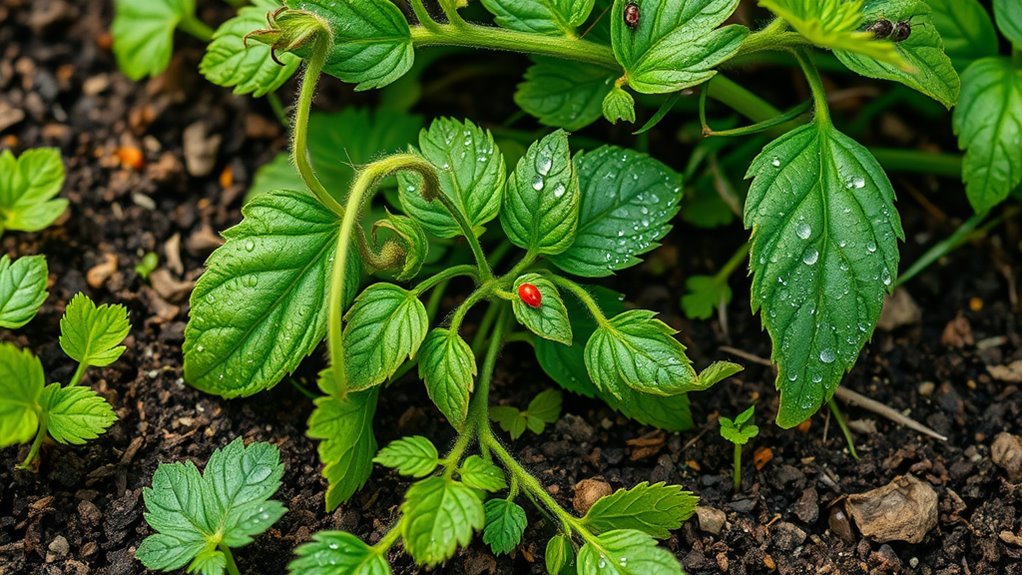What No One Tells You About Organic Gardening
You’ll uncover that organic gardening hides real challenges, like pests adapting to natural deterrents, demanding constant monitoring and crop rotation. Soil fertility requires regular compost addition and pH testing to sustain nutrients effectively. Companion planting offers hidden perks, such as repelling pests while boosting pollination. Water conservation through mulching and drip irrigation saves resources smartly. Enhance plant resilience with inoculants and sustainable practices—uncover more ways to elevate your garden’s success.
The Hidden Challenges of Organic Pest Control
Have you ever wondered how organic pest control can turn from a simple idea into a complex battle?
In organic gardening methods, you’re constantly monitoring for resilient pests that adapt to natural deterrents like neem oil or beneficial insects. You must rotate crops and introduce predators actively, but weather shifts and pest evolution demand precise timing to avoid infestations without disrupting ecosystems. Additionally, using homemade organic pest control can provide an effective solution for managing pests without harming beneficial organisms.
Secrets to Enhancing Soil Fertility Naturally
How can you naturally boost your soil’s fertility while maintaining a healthy ecosystem?
You’ll enhance it by adding compost and organic matter, which supply nutrients and boost microbial life. Additionally, incorporating nutrient-rich compost into your soil can significantly improve its structure and water retention. Plant cover crops like legumes to fix nitrogen and reduce erosion. Test soil pH regularly and amend with lime or sulfur for balance. Rotate crops to replenish key elements and prevent depletion, fostering long-term health.
Overlooked Benefits of Companion Planting
While companion planting might seem like a simple pairing of plants, it delivers several underappreciated advantages that boost your garden’s health and yield.
You’ll find it naturally repels pests, like marigolds warding off nematodes from tomatoes.
It enhances pollination by attracting beneficial insects, while nitrogen-fixing beans enrich soil for neighbors.
This approach promotes biodiversity, making your plants more resilient and productive with minimal effort. Additionally, companion planting can create a thriving garden ecosystem by fostering relationships between different species that support each other’s growth.
Unexpected Techniques for Water Conservation
You’ll find that mulch layering techniques let you retain soil moisture effectively by creating a barrier against evaporation in your organic garden. Implementing drip irrigation hacks allows you to deliver water directly to plant roots, cutting down on runoff and waste. These approaches help you optimize resources while maintaining a healthy, eco-friendly setup. Additionally, using innovative mulching techniques can further enhance moisture retention and improve overall soil health.
Mulch Layering Techniques
Mulch layering offers innovative ways to conserve water in your organic garden.
It’s a practical, scientific method that minimizes evaporation and sustains soil moisture.
- Start with a base layer of cardboard to block weeds and retain water effectively.
- Add coarse organic mulch like straw to promote air flow and slow evaporation.
- Incorporate a compost layer to improve soil structure and boost water-holding capacity.
- Finish with a top layer of bark or leaves to shield soil from sun and wind.
Drip Irrigation Hacks
How can you maximize water conservation with innovative drip irrigation hacks?
Install a smart timer to automate watering based on soil moisture sensors, preventing over-irrigation and saving up to 50% of water.
Position emitters under mulch to target plant roots directly, minimizing evaporation losses by 70%.
Integrate rainwater harvesting systems, like barrels linked to your setup, for efficient, sustainable reuse.
Fine-tune flow rates to match plant needs, avoiding runoff.
Surprising Ways to Boost Plant Resilience
You can strengthen your plant’s root systems by encouraging deeper growth, which helps them withstand environmental stresses.
You’ll find that using cover crops not only prevents soil erosion but also improves nutrient uptake.
Plus, boosting microbial health in your soil fosters a balanced ecosystem that enhances overall plant resilience. Additionally, soil testing can identify specific nutrient deficiencies, allowing for targeted amendments that further support plant health.
Strengthen Root Systems
Strengthening root systems reveals surprising ways to enhance plant resilience, drawing on scientific principles like symbiotic fungi and soil biology.
You can boost your plants’ roots by:
- Applying mycorrhizal inoculants to form symbiotic networks that improve nutrient uptake and water efficiency.
- Aerating soil regularly to enhance oxygen flow, fostering deeper root penetration.
- Monitoring moisture levels precisely to avoid compaction and promote healthy growth.
- Adding targeted organic amendments to stimulate beneficial microbial activity for stronger structures.
Use Cover Crops
While traditional methods focus on direct root enhancement, cover crops introduce unexpected strategies to fortify plant resilience by fostering soil health and biodiversity.
You’ll plant species like clover to suppress weeds and prevent soil erosion, actively improving structure for better water retention.
This makes your garden more robust against droughts and nutrient loss, allowing you to rotate crops effectively for sustained vigor.
Boost Microbial Health
Boosting microbial health in your soil uncovers innovative ways to enhance plant resilience, drawing on the power of beneficial bacteria and fungi.
You’ll be truly surprised at how these practices work.
- Add high-quality compost to introduce diverse microbes that efficiently break down nutrients.
- Employ cover crops like clover to fix nitrogen and support fungal networks.
- Introduce mycorrhizal fungi for symbiotic root relationships that boost nutrient uptake.
- Minimize tillage to preserve microbial habitats and promote soil stability.
Lesser-Known Strategies for Sustainable Harvesting
How do you maximize your organic garden’s yield while preserving soil health for the long term?
You rotate crops to restore nutrients and disrupt pests, preventing depletion.
Intercropping boosts biodiversity, naturally controlling diseases and enhancing resilience.
Plant cover crops like clover to fix nitrogen and reduce erosion.
Time harvests to minimize soil disturbance, maintaining microbial activity for sustained fertility and productivity.

